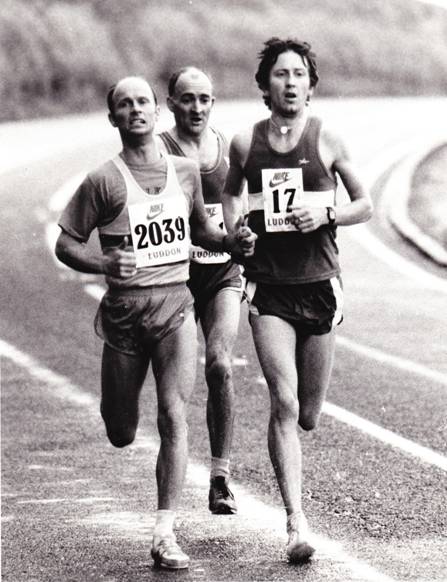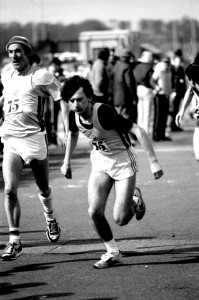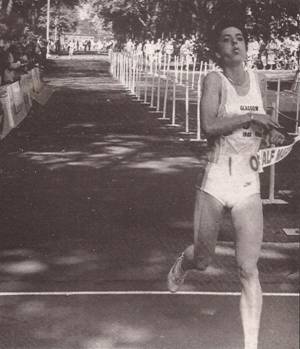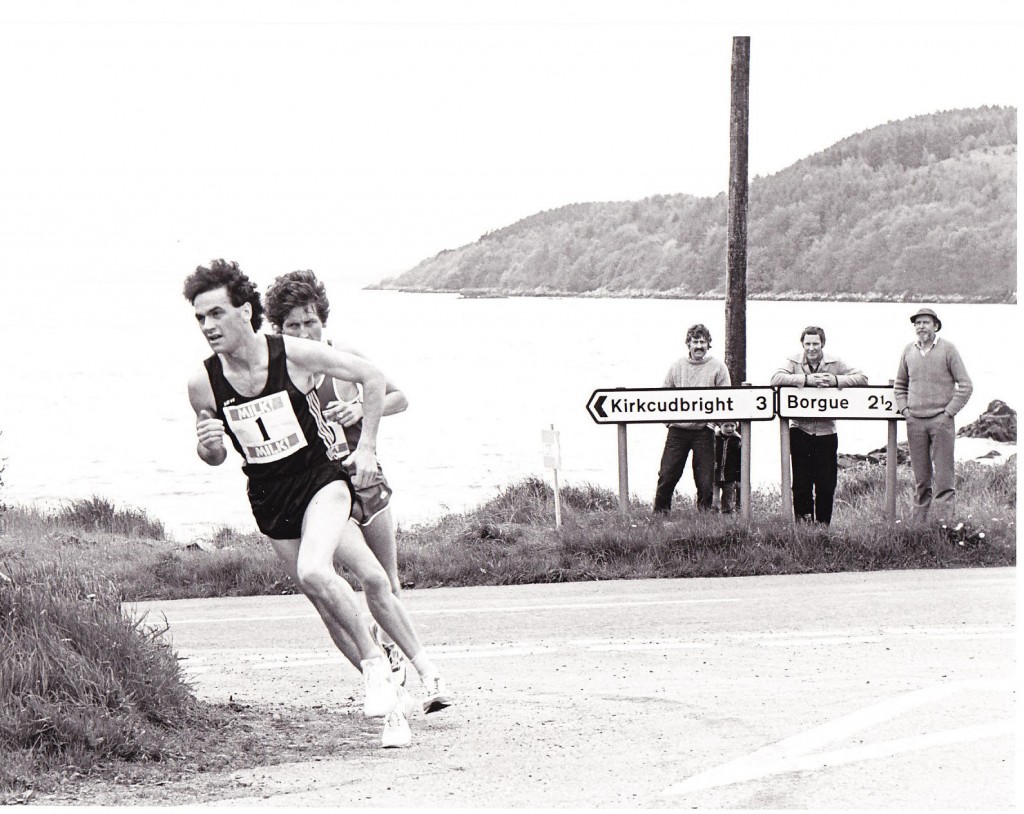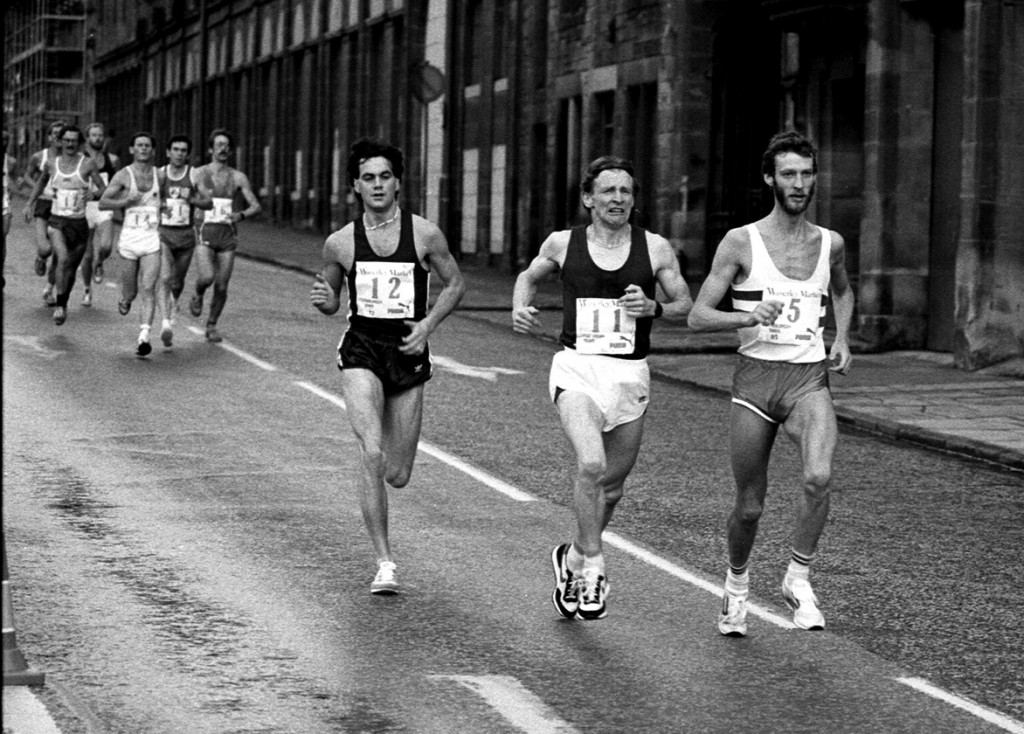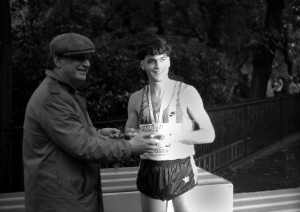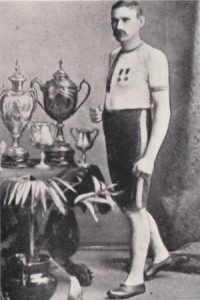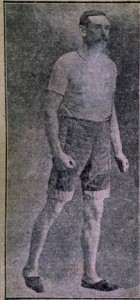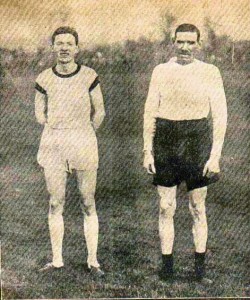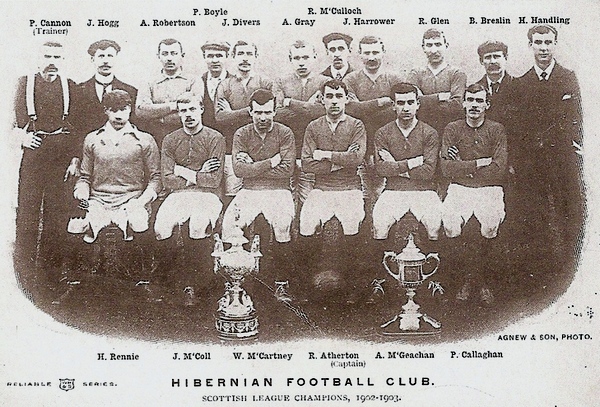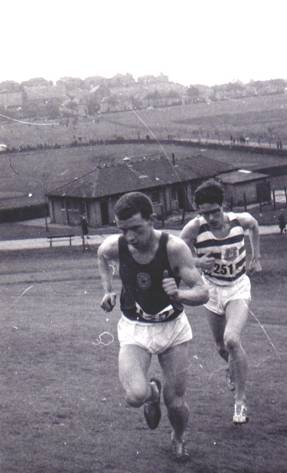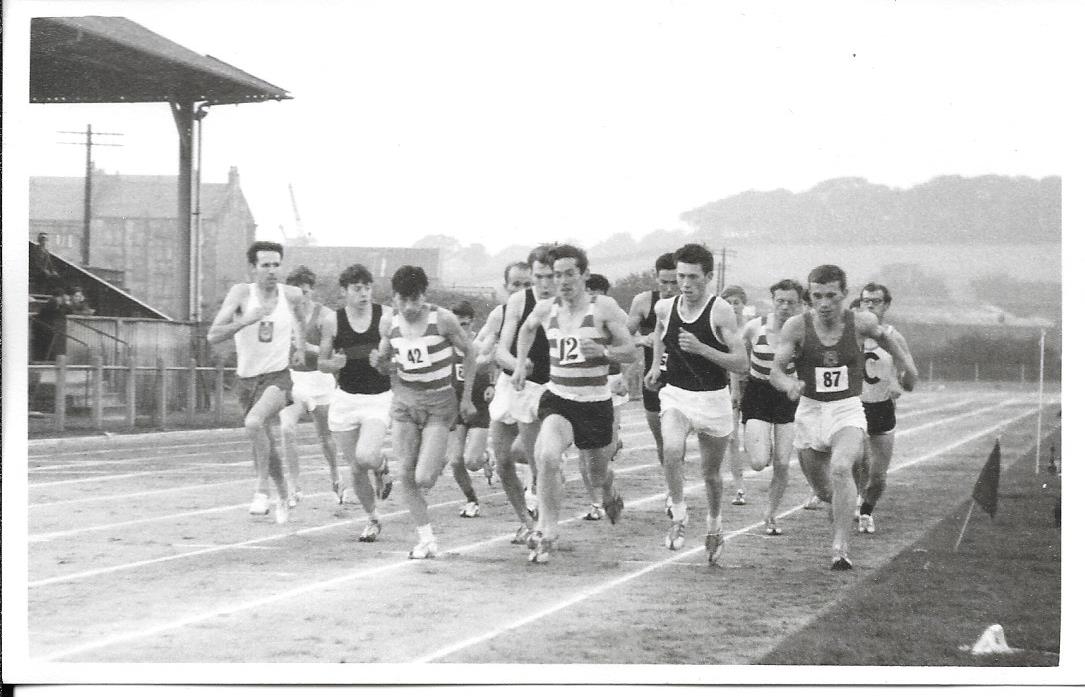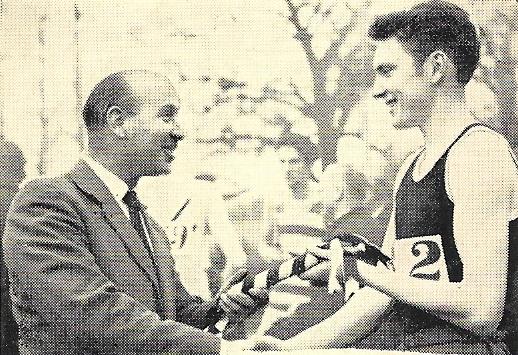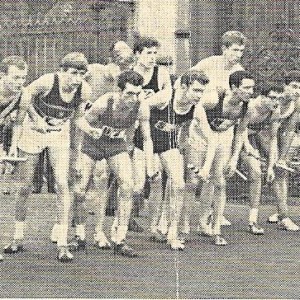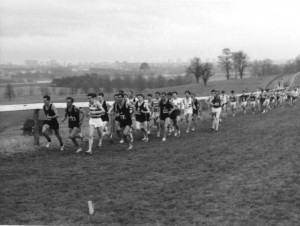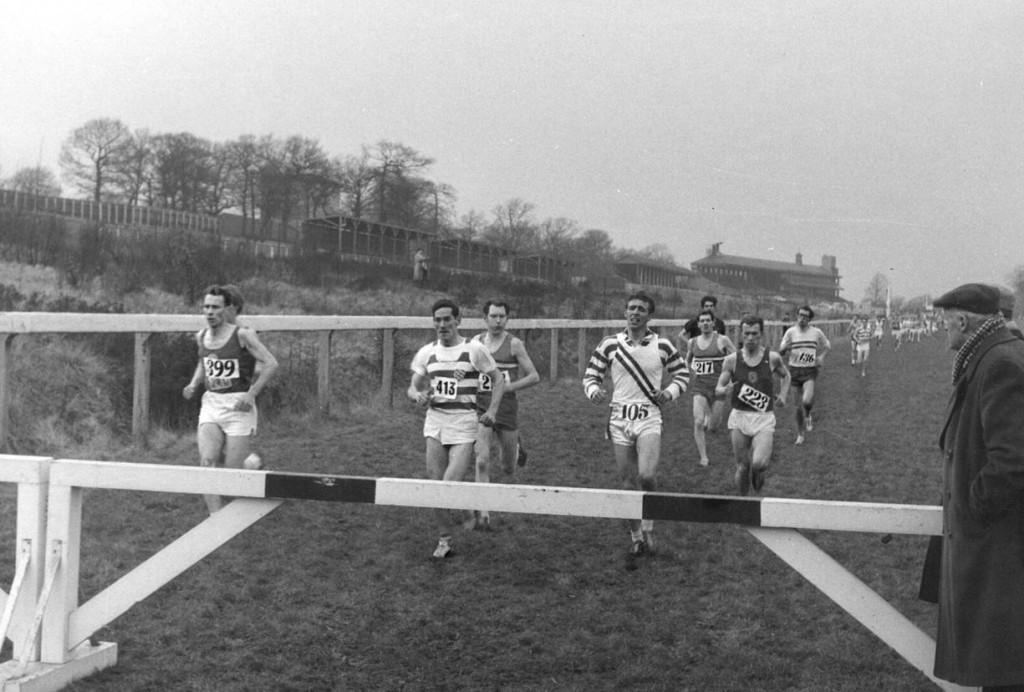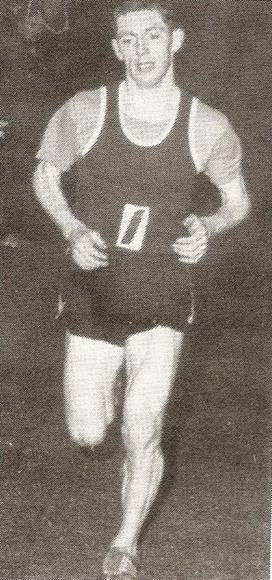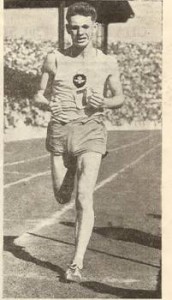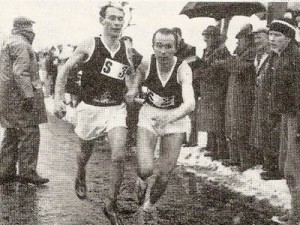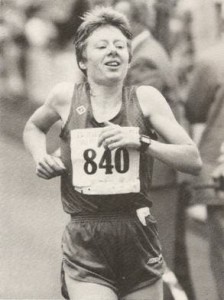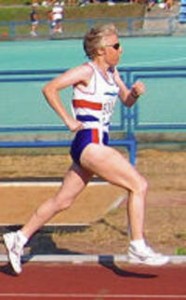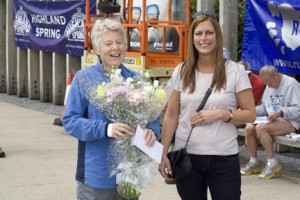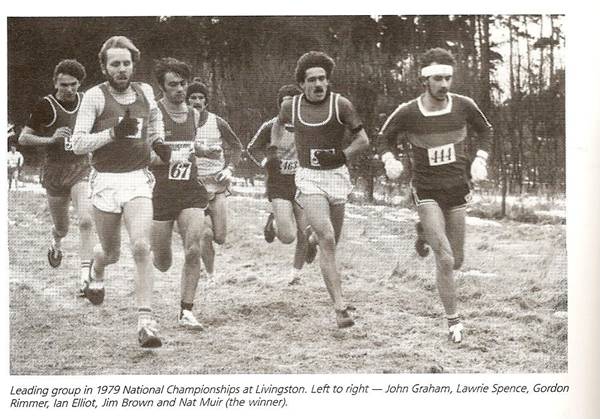
If you say “Jim Brown” to any distance running aficionado in Scotland they will immediately say “Cross Country” in response. There was a lot more to Jim than that – track running and road racing were equally good and when he turned to the marathon then there were good times there as well. Were we dealing with cross country or all round endurance talent he would have to be well up in the list. However we are focusing narrowly on the marathon here. We can inspect his cross country performances, look at his track running and then review his marathon running before reproducing his reply to the Scottish Marathon Club magazine questionnaire. That being said, his cross country running was masterly and in the early 70’s in particular he was quite outstanding. He ran seven times for Scotland in the Senior International team and three times for the Junior squad where he was third, then second and then, in 1973, first. He won the District titles (Junior and Senior simultaneously) in three consecutive years and then won the senior title. Let’s just lay them out clearly.
- Midland District Junior Championship: Winner in 1971, 1972 and 1973
- Midland District Senior Championship: Winner in 1971, 1972 and 1973
- Scottish Junior Championship: Winner in 1972 and 1973
- Scottish Senior Championship: 1974.
- Junior International Championship: Third in 1971, second in 1972 and first in 1973.
- Senior International Championship: Seven appearances (position in brackets)
1974 (4th), 1975 (75th), 1976 (24th), 1977 (36th), 1978 (114th), 1980 (31st), 1981 (DNF).
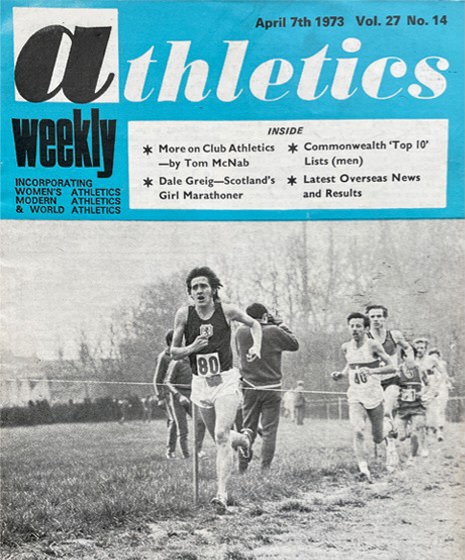
Jim winning the World Junior Cross-Country in 1973
On the roads over the winter season he ran superbly well and maybe his best were reserved for the Edinburgh to Glasgow in 1979 and 1980 when the Clyde Valley team won and Jim had the fastest times on the sixth stage in 1979 (starting in first place and running a faster time than Allister Hutton, Jim Dingwall and Lawrie Spence among others) and the fifth stage (1980). There were many other fine performances – eg in 1973 he pulled up six places on the second stage including Nat Muir and Alastair Wood.
How about on the track? Again he was a top talent and is still ranked in the top twenty of all time in the Two Miles (8:33.2 in 1975), 5000 Metres (13:39.0 in 1975) and 10000 metres (fifth with 28:00.62 in 1975). There were Scottish representative honours on the road and track as well as over the country.
So when he turned to the twenty six miles plus of the marathon there was genuine interest on what would be produced. In 1979 he raced to 2:22:22 on a fierce course in Aberdeen to be second to Graham Laing (Aberdeen) who was less than a minute ahead with 2:21:40. His fastest in 1980 was 2:19:03 at Milton Keynes to be ranked fifth in Scotland for that year. Not ranked in 1981 his best in 1982 was 2:20:38 to be eleventh Scot and he was not ranked on 1983.
Scottish Marathon Club Magazine: June 1986
Profile
Name: Jim Brown
Club: Motherwell YMCA Harriers
Date of Birth: 13/9/52
Occupation: Assistant Facilities Officer – Monklands District Council
Personal Bests: 1500: 3:49 3000: 7:58 5000: 13:39 10000: 28:00.6 10 Miles: 46:22 Marathon: 2:19:03
How Did You Get Involved In The Sport? It was by accident really, whilst in the Boys Brigade I was more or less volunteered along with four or five others to take part in the Motherwell Battalion cross-country championships at Cleland Estate. At that time most of my spare time was spent playing football or travelling to watch Motherwell. I was a pretty ardent ‘steel men’ enthusiast in those days. I was 15 when I ran at Cleland I remember the race very clearly, we were asked to follow a certain runner who would win anyway. as the course was not marked in any way. As the race progressed both of us broke clear and eventually I won on the run-in. I always remember the BB Captain saying he thought I was going to sprint out of Cleland Estate such was my enthusiasm over the last 100 metres. It was then I met John Waddell who persuaded me to start running with Bellshil YMCA. This had been my first introduction to cross country running and my attendance was very sporadic but in these early days it was the continuing promptings of John Waddell which introduced me to the sport. We have been friends ever since and he can still quote my DoB (for entry on the day purposes!)
What Do You Get Out Of The Sport? From my days as a Junior (17-20) I had built up a tremendous will to win. I loved the involvement and competition at National and International level, also the travelling and the pre-race atmosphere created eg San Sebastian. I always felt I thrived on those conditions. I’ve also struck up many friendships at home and abroad and met some really interesting characters – competitors and officials alike.
Can You Describe Your General Attitude To The Sport? Until my years as a Junior I had a really easy going attitude to races. For those who can recall I was usually the bridesmaid to Ron McDonald. My attitude was really shattered by Alec Johnstone, an official with the SCCU during my first ever trip to San Sebastian – I finished second to Fava of Italy. I was reasonably pleased with my afternoon’s work as I thought was Alec. Whilst chatting to him applause broke out at the finish area, this was for Fava to receive his winning trophy in the stand. Alec Johnstone casually turned to me and said, “That’s the difference between being first and being second – he’s up there and you’re down here.” He never added anything else but I’m positive I became a better and more aggressive runner from that moment.
Has Any Individual Or Group had A Marked Effect On Either Your Attitude To The Sport Or On Your Performance? I think in my early days my first coach Bob Henshaw helped shape my attitude. He was a professional sprint coach and during my first two years under him he taught me tremendous restraint and patience in training. I was beginning to handle training workloads and was always looking for longer workouts but he was an advocate of set work loads and never tried to run me into the ground. In my later days at Borough Road College I was very impressed with Phil Banning who I found was a very organised, systematic and forthright character. I think we were the same in some respects but we tended to dodge each other in training because when we got together the rest of the team were posted missing as he, like me, wanted to be number one, even in training runs.
What Do You Consider Your Best Performance? Regards time and ranking 28:00.6 10km run at Crystal Palace when finishing second to Dave Black is looked on as one of my best runs. I think it ranked me seventh in the world that year, although personally I took as much pleasure at dipping under 3:50 for 1500m for the first time.
And Your Worst? I think it must have been the 1976 Olympic Trial at Crystal Palace. Previously I had been ranked third in Britain due to my 10k the previous year. It was my final year at College, I was due to sit my Physical Education finals and although my training, especially speed work, had been going well, my competitive work outs that year had been terrible. I went for broke, went through halfway in just over 14 minutes. I recall the elation of thinking that I was nearly in the team but it was short lived as I tied up and finished the last half running backwards. I don’t think I have ever been so depressed or disappointed after a race.
What Do You Do Apart From Running To Relax? I enjoy club nights at Motherwell. We’re building up a strong squad and there’s nothing better after the Tuesday ‘Steady 10’ than a few beers. Besides training, my two little girls Sharlene and Deborah tend to take up most of my time, although my wife and I are very partial to Indian food and we tend to do the rounds of the Indian night spots! I’m first to admit that it doesn’t do a lot for your early morning run!
What Goals Do You Have That Are Still Unachieved? I’ve had a lot of calf trouble in the last year and my training has been curtailed. I’d just like to be injury free and enjoy the road racing scene. I’ve no immediate goals – I’d like to speed up a bit as I enjoy the shorter road races and forget about marathons for a while.
What Has Running Brought You That You Would Not Have Wanted To Miss? The travelling and meeting people as already mentioned, also the rewards, when winning major events, for the months or years of conditioning. The involvement at club level and some of the characters one meets, we had our share at Clyde Valley, mentioning no names – I don’t want to start any rumours.
Can You Give Details Of Your Training? Injury free, I run between 70 and 90 miles a week in winter including one rep session of one and a half or two minute reps, these sessions are usually part of a 7 – 8 mile run with the time of the repetition being the recovery. The rest of my runs are made up of lunchtime 5 – 6 and easy evening 6 or 7 with a 10 mile club run on Tuesdays and a long run on Sunday, between 15 and 20 miles. I run most of my sessions at around 6 minute a mile pace. I’ve tried the pre-breakfast run at various times but I find I’m more sleep walking than perpetual motion, so my first venture out is always around lunchtime. Although I work at a leisure centre I only have around 45 minutes to fit in a run and I’m usually on call between the three sports centres in the District. I also work shifts so if I’m on a late shift I generally try to run about a further 7 – 9 miles in the morning. I like to compete once every three weeks which fits in with my shifts. In the summer I usually run around 80 miles a week – most runs are made up of 5’s or 6’s. I run two rep sessions sometimes three a week. 6/8 x 2 minutes, 8 x 1 minute and one track session of 200 or 300 with a short recovery. My rep sessions are run on grass or cinder paths.
What Changes Would You Like To See In The Sport? I’d like to see more athletes taking up posts in administration at SAAA and SCCU level. We’ve had occasions in the past when officials have been accompanying teams abroad who have no idea how to encourage or motivate an athlete and have the awful habit of saying the wrong thing at the wrong time. Perhaps it is now time for full time paid officials – with a background in the sport, not someone stipulating that you should be wearing white shorts and a certain style of track suit prior to an event.
On the competitive side I think there are too many half marathons and marathons, we’ve already had a few fatalities. I feel that 5k and 10k road races should be encouraged more as too many people are jumping on the marathon kick. Gradual progression is the key.
Jim’s first run in the Junior Cross-Country International was in 1971 and we will start the rest of this profile in that year when he started racing against Seniors. The summer of 1971 was one in which Jim and his friend Ron McDonald totally dominated the endurance events in Scottish athletics in the junior age group. In the 1500m, Ron was top with 3:46.0 (run on the cinders at Rawyards Park, Airdrie) with Jim third with 3:51.5 (at Birmingham) and they were separated by Frank Clement on 3:48.0. McDonald topped the 3000m with 8:07.2 at Helenvale, with Brown second with 8:08.4 at Crystal Palace, Brown led the 5000m rankings with McDonald second (14:03.4 at Meadowbank, and 14:24.6 at Scotstoun). Brown was also second in the 2000m steeplechase (5:50.0 behind Kilpatrick’s 5:41.8) and 3000m steeplechase (9:23.6 behind Kilpatrick’s 9:20.0). The domination was competitive as well as time based: McDonald won both the SAAA Junior 1500m and SAAA Junior 5000m, while Brown won the Junior 2000m steeplechase and was second in the West District 1500m behind Dave McMeekin. At Senior level, McDonald won the West District 800m and Brown was third in the SAAA Senior 5000m. The Scottish Athletics 1972 yearbook commented: “Ron McDonald and Jim Brown successfully challenged the best of Scotland’s seniors in open races and were clearly superior to the rest of the juniors who nevertheless contain some talented performers. Brown finished second and McDonald third in the AAA Junior championship race, and then tied for first place with Junior multi-record holder Dave Black, when representing Great Britain in a Junior International v West Germany and Sweden.” So nobody could say that the Seniors hadn’t been warned.
However, many good young Youths come up and make an impression in the Senior Ranks as Juniors – but none had made an impact like Jim did in winter 1971-72, or made it so quickly. The winter season usually begins with the McAndrew Relays in October and Jim’s McAndrew debut was on 3rd October 1970. Immediate impact. The headline in the Glasgow Herald read “FASTEST RUNNER IN McANDREW RELAY DISQUALIFIED” – and it was Jim they were talking about. No doubts about the quality of the run, he was faster round the course than Don Macgregor, Lachie Stewart, Norman Morrison, Alastair Johnston and all the other top men of the day. “The revelation of the day was the run by 18-year-old Jim Brown the former Bellshill YMCA member who has moved to Monkland Harriers. That change of club however automatically brings a 14-month suspension from team competitions on an individual, and Brown’s time is nowhere near served. And so, despite leading home a record field of 83 runners on the first leg and unbelievably finishing up the fastest man in the whole race, Brown was rightly discarded from the official results and his team disqualified. Nevertheless this cannot detract from his great run.” Jim had gone straight to the front and handed over 30 yards up on Norman Morrison, his final time was two seconds quicker than Don Macgregor who received the award. Unable to run in the Lanarkshire Relays or the Kingsway Relays in Dundee, he next raced on 24th October in the Scottish YMCA relay at Bellshill where he had fastest time of the day. All well and good but the top opposition did not compete in the YMCA event. They were not to appear again until the Glasgow University road race on 14th November. This time they were head-to-head – Fergus Murray, Alistair McKean, Donald Macgregor, Hugh Barrow and company faced the starter along with Jim Brown. “Jim Brown, the Monkland teenager who shook all of us six weeks ago by running the fastest time in the McAndrew Relay, came back on Saturday in the Willie Diverty Memorial Road Race with a reminder that his initial claim for attention was no seven-day wonder. The eight-stone stripling with the broad Lanarkshire accent audaciously forced the pace against the world-travelled schoolmaster from Fettes College, Fergus Murray, ten years his senior, as the pair of them battled over the closing stages they presented a picture of two runners poles apart in so many departments. For anyone looking for a fairy-tale ending there was a disappointment. Murray controlled matters over the last three-quarters of a mile of the five mile course and entered the gates of Westerlands having at last subdued this youngster at his heels. The Edinburgh man completed one lap of the track finishing in 24 minutes 41 seconds which takes an enormous 35 seconds off Lachie Stewart’s record of three years ago. Brown was a mere three seconds behind in recording his most satisfying performance since taking up the sport. Afterwards he said he hadn’t expected to beat his more experienced opponent but was delighted at having come so near. Murray too was impressed, “I think he has a big future. He was certainly setting a fast pace – one I was quite content to follow.” Jim Brown had certainly arrived. The next test was for a SCCU select in a four-way competition at Durham on 5th December against Northumberland & Durham, Northern Universities and Morpeth Harriers. One of the main aims of this fixture, and others that season, was to give some of the younger Scottish runners experience outside of their own home area. How did Jim do this time? Well he was fourth overall and first SCCU runner home behind Jim Alder, John Caine and Ernie Pomfret, but ahead of such as Maurice Benn, Tom Grubb and Willie Day. A week later, running for the SCCU in their B team match against Scottish Universities at Knightswood Park in Glasgow, Jim was second to his Monkland team mate Ron McDonald, beaten by only four yards. Third was Alastair Johnston of Victoria Park – 6 seconds down on Jim. The classic road race start to the New Year was the Nigel Barge race promoted by Maryhill Harriers and in 1971 it was on 5th January. Almost all the top men were there – along with Jim and his team mate Ronnie McDonald. This time the winner was Ronnie – the finishing sprint of the top-class miler was enough to give him victory ahead of Dick Wedlock, Gareth Bryan-Jones and Alistair Blamire with Jim Brown sixth. He lifted a few good scalps here too though.
With the Nigel Barge past, attention was on the Championships and the representative outings. The first of these was the Midland championship on 23rd January at Stirling University. The headline and report read as follows:
“BROWN COOL AND CONVINCING MIDLAND TITLE WINNER. Jim Brown, the 18-tear-old Bellshill Academy schoolboy, ran his way back into the headlines on Saturday with an easy-looking win in the Midland District cross-country championship. The course, at Stirling University’s playing fields, was as severe as any on the Scottish circuit but the lightweight Brown skimmed over the mud and stones as if he were on a summer track. He covered the six miles in 30 minutes 04 seconds and finished looking almost as cool as he had at the start. Coming in over 60 yards behind was Norman Morrison (Shettleston) a 1500m runner in the Commonwealth Games , and about the same distance behind him came Alistair Johnston (Victoria Park). Those three had dominated the race virtually from the start. Brown looking almost too young and spare of flesh to be a senior winner flicked the caked mud off his body as he expressed surprise at the way the race had unfolded “I thought the pace was kind of slow. With only three of us clear of the field after the first lap, I just decided to go to the front and see how things went. Norman seemed to drop back and I knew the race was mine.” It should be noted though that none of Lachie Stewart, Ian McCafferty or Dick Wedlock was running. The following Sunday, Brown was in San Sebastian where he finished second in the international Junior race over 6200m less than eight seconds behind the winner, Fava of Italy. In Madrid on 13th February, Brown was third in the Junior international won by his Monkland team mate Ron McDonald. Frank Clement was sixteenth and the team finished second. McDonald and Brown were lso first and second in the National Junior CC Championships at Bellahouston and were picked for the team to contest the international at Spain in March. Before then there was the Scottish Schools cross-country championships in which Brown, running for Bellshill Academy beat McDonald (St Patrick’s, Coatbridge) by half a minute. In the International, Jim was third with the team second – Ian Gilmour was thirteenth and Ron McDonald fourteenth on a muddy course with a heavy wind blowing. It had been an excellent first season against the seniors with the bronze medal in the international the icing.
Jim had finished summer 1970 ranked in three different events – his best time for the 1500m was 3:57.2 which ranked him 23rd in Scotland, the 3000m 8:39.8 which ranked him 24th and the steeplechase where his 9:24.2 ranked him seventh in Scotland. Coming off the back of the winter he had just had, it was expected that he would be much quicker in the summer of 1971. The Glasgow Corporation Sports were held at Scotstoun on 22nd May and Jim Brown won the steeplechase in 9:23.2 – exactly one second faster than his best of 1970. Unplaced, if indeed he ran, in the West Districts the following Saturday, he was next in action at the Airdrie HG at Rawyards Park at the start of June where he won the open 5000m in 14:20.8 – a full 25 seconds ahead of second placed Dick Wedlock and a further 10 in front of Paul Bannon in third. Club mate Ron McDonald was turning in more than a race a week at this point over 800/1500/mile distances and winning them all. On 19th June it was the Scottish Schools championships and McDonald and Brown both won their respective events – McDonald the 5000m in 14:24.6 and Brown the 2000m steeplechase in 5:55.4, a best championship performance – which set them up nicely for the SAAA Championships the next Satrday. Brown was third in a very good 5000m behind Ian McCafferty and Adrian Weatherhead in 14:03.4, and McDonald lost the 1500m by 0.2 seconds to Craig Douglas. It should be remembered that Brown was a fast miler as well as an endurance specialist: on 3rd July, for instance, he ran against Ron McDonald and Frank Clement in a Graded championship meeting at Grangemouth Stadium. “The event which created the greatest interest was the 1500 metres in which three top-class juniors met – Ronnie McDonald and Jim Brown (both Monkland Harriers) and Frank Clement (Strathclyde University) Brown led at the end of the first lap and, although McDonald took over temporarily, Brown stepped up the pace in the second lap, closely pursued by Clement. The unflappable McDonald was content to stay in the first three. In the back straight over 300 yards, Brown believing that the only way to beat McDonald was to take him that distance in a buirst of speed, put in all he knew in an effort to shake off his clubmate. Undaunted, McDonald held on and he and Clement fought out the finish in which McDonald recorded the best championship time of 3:59.2, Clement was second in 3:49.8 and Brown third in 3:51.5.”
On 17th July Jim suffered a rare defeat in schools athletics when he finished second in the 2000m steeplechase in the schools international at Meadowbank where he was beaten by Ian Kirkpatrick of England. The trouble seemed to be that the Englishman was a much better hurdler than he was and the reporter felt, probably rightly, that Jim should have been selected for the 5000m. His time was 5:50, 7.2 seconds down on the winner. It was though a good summer with Brown racing against his elders as often as he could. One such race was the 3000m team race at Cowal at the end of the season where he took on Lachie Stewart – “In the 3000 metres team race, Stewart found once again that his chief opponent for individual honours was the younger Jim Brown (Monkland) who tried hard to hold his more experienced opponent over the seven and a half laps of the course. Brown failed to live with Stewart in finishing tactics, however, and lost by eight yards.” By the end of the summer he was ranked in 56 events with every time better than the year before. In the 1500m he had run 3:51.5 to be 13th in Scotland, in the 3000m his 8:08.4 ranked him 7th, at 5000m his best of 14:03.4 had him in sixth place and his steeplechase time of 5:50.0 for 2000m and 9:23.6 for 3000m ranked him second and sixth respectively.
Winter started for distance runners on the first Saturday in October at Scotstoun in Glasgow at the McAndrew Relays where Jim Brown had raised more than a few eyebrows the previous year. This time he was again the fastest over the course. “Brown, now a legitimate member of Monkland Harriers, was even more spectacular this time. He took up the challenge on the second leg and fought his way from twelfth to second position behind Shettleston. En route he always looked menacing and although Lachie Stewart was a mere figure in the distance, Brown must have pulled him back 120 yards by the time he finished. Anyone doing that to a commonwealth champion is someone to be reckoned with.”
In the Lanarkshire Relay the following week, Jim had by far the fastest time of the day when Monkland finished second to Springburn with Shettleston third. At the very end of October in the Allan Scally Relay at Shettleston, Jim Brown took over in 27th place and picked off all but four of them, inevitably turning in the day’s fastest time equalling the course record of 22:09 when he ran the second stage – Ronnie McDonald pulled the cub int third on the last stage. A week later in the Midland Relay at Bellshill, he had the day’s fastest time, 10 seconds faster than Dick Wedlock and 13 seconds better than Lachie Stewart. Missing the University 5 at Westerlands where Fergus Murray defeated him the previous year, Brown ran in the Edinburgh to Glasgow Relay on 20th November. Running on the fourth stage, he moved Monkland up from twelfth to sixth with the fastest time of the day, a full minute quicker than the next best. From a great run on the roads to a very good one over the country at Parliament Hill Fields in London, Brown finished fifth and second Scot (Lachie Stewart was fourth) in a race won by David Bedford who was only 14 seconds ahead of the 19-year-old Scot. As a wee aside, the ‘Glasgow Herald’ pointed out that ‘plucky’ young Jim Brown’s big worry in the race was counting the laps and, near the end, he had to ask Lachie Stewart if they were really on the last lap. The next major race for him was the Midland Championship at Bellshill where he had a head to head with Ian McCafferty while Lachie Stewart, Dick Wedlock and Ron McDonald were competing at Elgoibar. The ‘Glasgow Herald’ of 24th January, 1972 read “McCAFFERTY AND BROWN TAKE A STEP NEARER MUNICH. Jim Brown and Ian McCafferty took a step nearer Munich at the weekend when they plumbed depths of stamina at the weekend that left a huge field in the Midland cross-country championship helpless to respond. Brown, the 19-year-old Monkland Harrier, retained the title at Bellshill and thus kept his unbeaten record in domestic competitions this winter, but what a challenge McCafferty offered in only his second outing of the season – his previous having also ended in defeat by Brown. Sporting a Mexican-type moustache and long hair, McCafferty gave the holder the treatment he had been hoping to avoid – a hard punishing contest. After the race, which Brown won by six seconds, he said “I had been hoping for an easy one here today because of the San Sebastian race next Sunday, but there’s no doubt about it – McCafferty’s fit all right, I thought he ran very well.” It couldn’t have affected Brown too much because he won the Junior 6000m race in Spain by 17 seconds from England’s Bernie Ford.
The Scottish Junior Cross-Country Championship was on 19th February at Currie and Jim Brown won from Paul Bannon by 29 seconds and gained selection for the international championships at Cambridge in March. The date was 18th March and Brown had been third the previous year. “Jim Brown won the silver medal in the junior race behind Aldo Tomasini (Italy( but until the lats 100 metres he was heading for nothing better than the bronze. Suddenly Franco Fava, the other leading Italian, who was well clear of the Scot staged a Jim Peters type stagger and, as if in slow motion, the exhausted Fava slumped to the grass. Brown, revitalised, sprinted 30 or 40 yards, passed the luckless Italian, who to his credit, managed to stagger to his feet and struggle his way over the line for third place.” Two world junior championships, a third and a second – good going!
That summer (1972) Jim was ranked in four events and won two championship medals. Third in the 5000m and second in the 10000m his best times for the year were 3:53.2 for the 1500, 8:17.4 for the 3000m, 13:59.8 for the 5000m and 28:57.8 for the 10000m. In the 10000m championship, he was first in 29:25.13, thirteen seconds in front of Fergus Murray. This championship was held in the GB v Poland international match at Meadowbank one week before the Scottish Championships and the photo-finish showed his time as 29:25.13. The SAAA 5000 came the next week and he repeated his bronze medal of 1971 being behind David Black (Small Heath) 13:51.4, and Lachie Stewart (Shettleston) 13:58.8 with his own time being 13:59.8. This title earned him selection for the GB international against Greece and the Netherlands in Athens the next week again. He was a replacement for the injured Ricky Wilde and was described by Athletics Weekly as ‘a wobbly and plucky second’ behind Grenville Tuck in 29:47.0. Clearly in brilliant form, just two weeks later he was seventh in the AAA 10000m at Crystal Palace in 28:58. On 16th September Jim won an Edinburgh Southern Floodlit Meeting at Meadowbank in 14:00.0
n 7th October 1973, the ‘Glasgow Herald’ ran with the headline and article:.
“BROWN SMASHES RECORD BUT SHETTLESTON WIN.
It was hardly surprising that a good many of the runners in Saturday’s McAndrew Relay in Jordanhill, Glasgow, found it hard to swallow the extraordinary time set up by Jim Brown (Monkland Harriers) on the second leg. Brown makes a habit of drawing attention to himself in this opener to the official cross-country season, a four-man road relay covering a circuit something short of three miles. Two years ago he was the fastest individual, but was disqualified for competing while serving a 14-month suspension imposed automatically when a runner changes from one club to another. Last year everything was legitimate and he was again individual prize winner. On Saturday Brown, wearing the now fashionable hairband, resembled some obsessed dervish as he thrashed his way round the course, dragging his club from the thirteenth place they occupied when he took over to an unbelievable second, behind Shettleston Harriers, the eventual winners. Monkland, however, dropped to seventh after the remaining two legs. The really astonishing feature was Brown’s time – 13 min 2 sec – which smashed Lachie Stewart’s seven-year-old record by 18 seconds, roughly equivalent to a distance of about 120 yards. After recovering from this early-season effort Brown said he had had to stop training after the AAA championships in July because of a strain in his right calf. It persisted for weeks, but now he is back into a strenuous schedule which for the moment seems to be paying dividends. His major ambition is to impress sufficiently next season over 10,000 metres to put himself in line for the Christchurch Commonwealth Games, just 16 months away.” The first three teams were: 1 Shettleston H 55.22′ 2 Victoria Park 55.47; 3 ESH 56.17. Fastest individuals were Fastest: JB 13.02; N Morrison (Shett) 13.20; P Bannon (GU) 13.30; JL Stewart (Shett) 13.32; Colin Youngson (VP) 13.36; D Macgregor (ESH) 13.37.” The time was outstanding and when you look at the supporting cast of Morrison, Bannon, Stewart and Macgregor, you realise just how good. The next big race was the Allan Scally Memorial Trophy Relay at Shettleston on October 28th and Jim Brown was fastest again (21.52) with Andy McKean (EAC) 21.58 and Norman Morrison 22.06. in second and third.
Jim was fastest man yet again in the Midland District Relay on 4th November at Lochinch in Glasgow: described this time as “the amazing workhorse of Monkland Harriers” who “thrives on adversity”, he moved from tenth to sixth on the last lap to be 18 seconds faster than Pat Maclagan who was next best runner. A week later and the runner described this time as “Scotland’s best and most consistent cross-country runner since the season began” suffered “an inexplicable lapse” and finished twenty fifth in an international race in London against the best of English and Kenyan runners. In the Edinburgh to Glasgow on the 18th November Jim was second fastest on the fourth stage, only 2 seconds behind Alex Wight of Edinburgh AC in the Monkland team that finished tenth. The next international was the match against Wales, and various English regions at Stafford. Scotland won from Northern Counties and the first three individuals were all Scots – Lachie Stewart first in 28:25, Jim Brown second in 28:27 and Ian Gilmour third in 28:55. Missing several races his next outing was in the Midland Championship at Bellshill on 20th January – and it was a third successive win for the Monkland Harriers – 31:36 as against 31:53 by second placed Alan Partidge (Susan’s Dad), and Dave Mc Meekin’s 32:18. A week later and Jim was in San Sebastian running in the Junior race – his third season as a Junior – where he won the 6.5 km race in 2:17.4 and Norman Morrison was second to Dave Bedford in the Senior race. The National on 17th February was won by Jim eleven seconds ahead of Lawrie Spence with Ron McDonald third and this gave the selectors a problem. As Ron Marshall said in the ‘Glasgow Herald’: “The vexing question over Jim Brown still remains. He is eligible to run as a Junior in Belgium, but would obviously be a marvellous asset to the Senior team, everyone is well aware of this. No matter how well our Seniors perform, there will be this nagging feeling that young Brown, had the ability to finish well up the field making a vital contribution to the points total. “ He was selected for the Junior team: how could he not be? He had been third in 1971, second in 1972 and still a Junior.
The International championships had previously been held by the ICCU but from 1973 they were to be held by the IAAF, and the first of these was at Waregem in Belgium. The IAAF had changed the qualifying conditions for Juniors such that “competitors had to be Under 21 years of age on the day of the race.” Brown was 20 years and 5 months on the day of the race and really went for the title right from the start, he ran away from Leon Schots (Belgium) on the second of three laps, and eventually won by 30 yards from Cianaros Haro (Spain) who was second. (Haro’s older brother Mariano was second in the Senior race.) Jim Brown had done it – third, second and now first in the Junior Championship. The fancied Scottish Seniors could do no better than eighth.
That summer (1973) saw Jim’s racing sabotaged by injury and his only mark of any note was a 5000m run in 14:27 which was almost half a minute slower than his 1972 time, at the Edinburgh Highland Games on 18th August. With the Commonwealth Games being held in Christchurch, New Zealand, in January, 1974, selections had to be made on form that summer so Jim unfortunately missed out on selection. He was also a notable non-starter in the early season races such as the McAndrew Relay, the Midlands Relay and the Glasgow University road race, making his first appearance in the Edinburgh to Glasgow Relay on 17th November where he moved up from fourth to first on the second stage with the third fastest time of the day. Monkland finished eighth team and were awarded the medals for the most meritorious unplaced performance. This was not an indicator that he would run in the County Championships the next weekend – the race was won by Ronnie McDonald but Brown was nowhere to be seen. It may be of course that the uneven surface and course conditions were a deterrent to one who had missed so much time through injury. His next appearance was on 5th January on the firmer and mostly safer surface of the roads around Maryhill where he was third in the Nigel Barge Road Race. Won by his clubmate Ronnie Morrison from Lachie Stewart in a sprint finish, Brown was ahead of Norman Morrison, Jim Wight and Don Macgregor and was obviously in very good condition. The Herald reporting at this point was not very satisfactory from the road and country running point of view, giving space and apparent precedence to comment, opinion and reporting on the upcoming Commonwealth Games in New Zealand at the expense of basic results eg the only time given for the classic Nigel Barge race was that of the winner, and no places were given below third and the following week the bulk of the space available was given to doping and the Games with the Springburn road race squashed into a bottom corner and not a single time, not even the winner’s, given. Jim’s comeback was cemented with his selection to run in Elgoibar in Spain on 19th January when he was fifth individual and first Scot in the team which won the international team race, the others being Lawrie Reilly in sixth and Frank Clement ninth over the 9200m trail.
Came the National at Coatbridge on 16th February, 1974, and the reason for Brown’s absence became clear in Ron Marshall’s report on the race: Jim was now studying at London. The report read:
“FORCEFUL BROWN RUNS McKEAN INTO GROUND
Jim Brown’s Physical Education studies at Borough Road College, London, are at least doing his running no harm. On Saturday at Coatbridge he became Scottish senior cross-country champion in the most convincing fashion, and yesterday he was an automatic choice by the selectors for the international cross-country championship in Italy next month. …. Brown, winner of the Scottish and International Junior titles last year, faces the daunting prospect of stepping up into the big league in Milan but if his forceful attitude on Saturday is an indication of how he intends breaking into senior competition then the rest of the runners are in for a nasty experience. He and Andy McKean, the defending champion, took little time in breaking away from the field of more than 400 starters and for two of the five laps of Drumpellier Park that made up the seven and a half miles course, they harried each other mercilessly. Up slippery grass slopes, down greasy grass, they fairly tore at each other. It was evident that some one had to give way at this relentless pace. McKean it was who conceded the leading position, but Brown was not content just to slip ahead. He dug afresh into the turf and mud stretching an astonishing gap between them. After three laps it was 20 seconds, after four it was half a minute, but some equality was established on the last lap, where McKean lost no more ground. Brown is in tremendous form, and is intent on building up over the next four weeks for a really serious crack at the senior title. He runs mostly in Richmond Park these days, covering about 90 miles a week, and has three college commitments in the next three weeks – the Hyde Park Relays, a contest in Madrid and the English Championships.”
In the English National on 2nd March, Jim had a good spell early in the race, challenging the leaders, he even looked a possible winner for six of the nine miles, but slipped back in the latter stages to finish ninth. But in the International on 14th March, he was back to his best.
“BROWN EXCELS ON A GOOD DAY FOR SCOTS
… The most important talking point, naturally, was the fourth place attained in the individual race by Jim Brown. His was a sterling. Blessed with an endless determination, Brown approaches every competition with the attitude, “Who’s going to be second?” And Saturday’s 12000m was no exception. Reputations had little meaning for the slim Monkland Harrier as he forged ahead at what seemed like a reckless speed. But the close attentions of Erik de Berk (Belgium), Mariano Haro (Spain) and Ray Smedley (England) indicated that something more punishing than Brown’s pace would be needed at the “killing off” stage. With half a lap to go the Scot showed signs of how sapping his efforts had been on him. De Berk and Haro became the principal actors, but as the Scot slipped reluctantly upstage, he could take ample consolation from the strength of his supporting role. The Belgian won in 35 minutes 24 seconds, a couple of strides in front of Haro.” Karel Lismont of Belgium was third, only passing Brown in the last few strides. Jim Brown was only 5 seconds behind the winner. Four runners within five seconds! It had been a good winter for him.
Having missed the Commonwealth Games in January, it was into summer 1974 in great shape for the track season. At Crystal Palace on 2nd June, he won a 3000m in 8:01.2 which placed him second at the end of the year – to Ron McDonald (7:55.2).
10,000m was clearly Jim’s best track distance, and the Yearbook later commented: “Former World Junior cross country champion Jim Brown ran brilliantly at this distance, producing three times under 28 and a half minutes. His fastest performance was just over three seconds behind Ian Stewart’s list-topping 28.17.2, run when he was sixth in the Christchurch Commonwealth Games on 25th January.”
At Meadowbank on the 22nd of June he was second (13.51.2) in the SAAA 5000m, behind Dave Black of England, who won in 13.38.4. On 12th July the AAA Championship 10,000m took place at Crystal Palace. Athletics In Scotland reported: “Jim Brown excelled himself by improving on his previous best 10,000m time by over half a minute to finish in a very good fourth behind Dave Bedford (27.48.6), Bernie Ford (28.15.8) and Tony Simmons (28.19.4). Jim’s time was 28.20.8, which places him in third place in the Scottish All-Time Rankings and won for him another UK vest, this time against Czechoslovakia at Meadowbank on 26th July.” Jim remembers that race well and was leading the field with two laps to go, lapping many good quality runners and thinking he’d get well inside his previous best time – maybe even get a 28:30 – when on the back straight with less than two laps to go, he started to fade and eventually dropped to fourth – and recorded well inside the 28:30 that he had been hoping for. Just one second behind Tony Simmons who was selected for the European championships on the strength of that run. Result for Simmons? Second in the Europeans! Jim’s performance in that high quality, international race was later considered by Colin Shields to be the best performance of the Scottish season. AIS again: “The most exciting race of the evening (actually closer than the 100 metres) was the 10,000 m, in which Jim Brown did exceptionally well. All four competitors, Jim Brown, Mike Baxter, Stanislav Hoffman and J. Jansky ran together throughout, with Baxter and Brown sharing the lead for most of the way. Hoffman took over at the bell, closely followed by Brown, Baxter, with the other Czech, Jansky, struggling. Jim Brown made a great effort on the back straight and overtook Hoffman to lead round the last bend. He appeared to have gone too early as, entering the home straight, both Hoffman and Baxter overtook him. All appeared lost for Jim with 50 metres to go until he displayed great fighting qualities by getting back on terms with the other two and crossed the line six inches behind Hoffman and just ahead of Baxter. Hoffman and Brown recorded the same time of 28.28.4, with Baxter two tenths of a second away third.” Athletics Weekly agreed that the 10,000m was the most exciting finish of the evening, and added that the speedy Hoffman had been a 3.39.1 1500m performer back in 1966. UK won the match overall, with 108 points to Czechoslovakia’s 102.
Then at Crystal Palace on September 25th and 26th, Finland’s Men’s team beat UK by a single point. On the second day of the match, Pekka Paivarinta (Finnish winner of the World Senior Cross Country Championship in 1973) defeated that year’s World Junior Champion, Jim Brown, in the 10,000m. Pekka recorded 28.18.4, and Jim his second-fastest time – 28.23.8, in front of Grenville Tuck (28.25.8) and Rune Holmen (28.48.2). AW reported: “Jim Brown and late replacement (for Dave Bedford) Grenville Tuck gave the 10,000 everything they had and the rewards went to all four runners in the shape of personal bests.” (A mistake by AW as far as Jim was concerned.) “Knowing the vast range of Pekka Paivarinta’s talent, they had no choice but to make the pace as hard as they could and hope he would drop. Brown led through 3k in 8.23.8 and 5k in 14.11.2, with all four runners together. Tuck took over the work and lapped in a steady 69 seconds, which dropped Holmen by 7k but Paivarinta always looked easy with his long relaxed stride. In the closing laps, Tuck and Brown could only manage to quicken the pace by a second or two and it was not enough. Paivarinta hit the front finally with 500 to go, but still the two Britons refused to give in and surprisingly the Finn had not burst away as expected. Brown and Tuck chased until 250m to go, when finally Paivarinta exploded and rocketed around the last 200m to open up a five second gap with a 57.6 last lap.” It was no disgrace to lose to such a great runner; and Jim Brown must have been proud to look back on such an impressive track season, with a new personal best and three international 10,000 metre races in a British vest.
*
That winter (1974-75) saw the appearance of a new name on the entry lists for Scottish races – the new club of Clyde Valley AC had been formed from four clubs in North Lanarkshire including Monkland. Jim would be competing henceforth as ‘Clyde Valley’. On 14th September, 1974, he won the Coatbridge 5 Miles Road Race by 19 seconds from Jim Dingwall, and then the following day he went to England and won the Berwick round the walls race. Two wins in two days. The new amalgamated club won the Midland Relays and in the ‘Glasgow Herald’ on 2nd November, Ron Marshall spoke of an interesting invitation to Jim. He wrote: “Jim Brown (Clyde Valley) has been asked to compete in the Canadian Cross-Country Championships in Montreal on Saturday week as part of a British team (the first time any team has competed cross-country under British colours). Brown’s Canadian trip will not be universally welcomed. His club, Clyde Valley, who won the Midland Relay on Saturday at Lochinch, had been nurturing the idea that a third place in the inter-city relay was within their grasp. With Brown away, their hope had been shattered, but they now intend throwing all their efforts into winning the national relay title the following week.” In the event, Brown did not go to Canada but ran on the sixth stage of the E-G and held on to third place with second fastest time of the day. No reason was given in the press for Jim’s absence from the Canadian venture but he also turned out for the club in the District Relays. Anglo Ian Gilmour could not make the trip to Scotland and Ray Baillie ran on the first stage where he finished eleventh. Next up for Clyde Valley was Jim Brown who moved from eleventh to first in the course of 10 minutes. He had fastest time of the day – 10:56 – and gave John Graham a lead of 24 seconds with Andy McKean the man in pursuit. McKean not only caught his man but gave Jim Wight 7 seconds start on Ron McDonald. McDonald was in great form all through 1974 and it was difficult to see anyone holding him off in such a position. McDonald won by 9 seconds with third fastest time of the day, only McKean splitting the two ex-Monkland men.
Absent from the domestic scene for the next few months although running well in the South , he won the race to celebrate the 75th anniversary of Barcelona FC over 8000m in Spain with Scotland winning the team race from England, Belgium and Spain. Other team members were Andy McKean 4th and Laurie Reilly 5th. The ‘Glasgow Herald’, remarked that after his ‘rather moderate’ 14th place at San Sebastian, he may concentrate on the SCCU Championships at Coatbridge rather than the English National at Luton. The prize for a good run was, of course, selection for the international in Morocco. Jim chose however not to run in the Coatbridge race but was nevertheless selected for the team to go to Morocco on 15th March. Jim ran but with Mariano Haro second to Scot Ian Stewart, the other Scots all ran poorly and Jim could only finish 75th. Others were A Hutton 38th, L Reilly 43rd, A McKean 54th, R Ward 81st, I Gilmour 88th, F Clement 89th, J Alder 106.
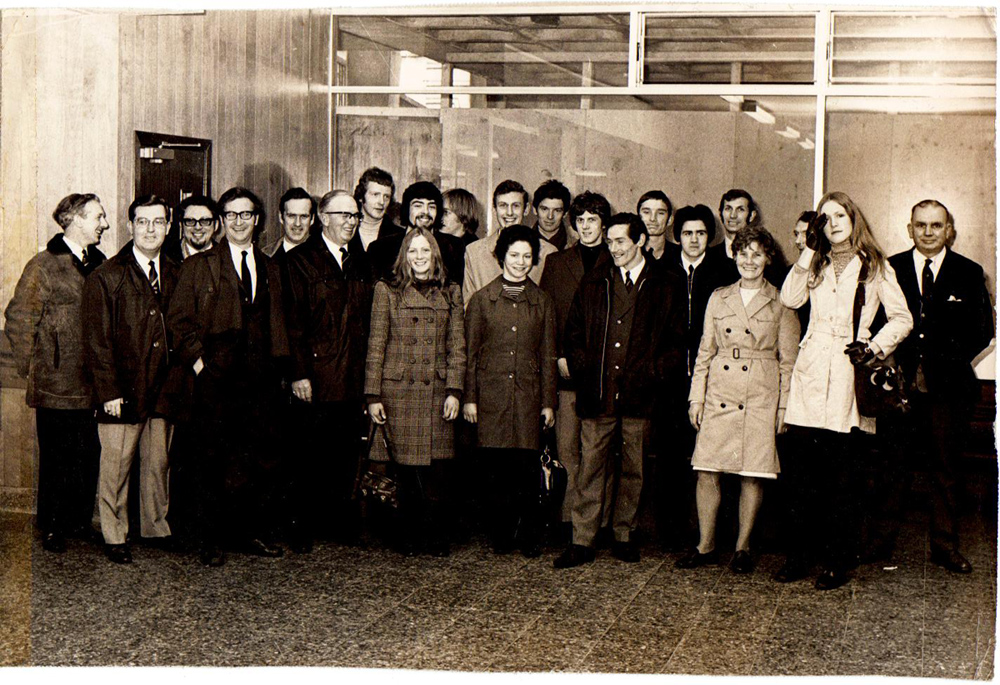
Scottish Teams for the International Cross-Country in 1975: Jim sixth from right, beside Lachie Stewart
Picture from Lachie Stewart
Into summer 1975 – possibly Jim’s best summer season. By the end of the season his best times ranked him in five events. He was second in the SAAA 5000m and also second in the AAA’s 10000m. The 10000m was a new Scottish National record – one which broke Lachie Stewart’s 28:11 from the Commonwealth Games in 1970 and which gave him great pleasure! It also ranked him third in Britain.
| Event |
Time |
Ranking |
| 1500m |
3:51.1 |
14th |
| 2 Miles |
7:58.0 |
|
| 3000m |
8:08.83 |
|
| 5000m |
13:39.0 |
2nd |
| 10000m |
28:00.62 |
1st |
| Steeplechase |
9:08.64 |
12th |
He had however started with a brilliant win in a local road race – the Tom Scott Road Race over 10 miles early April. It is worth reproducing the article in its entirety here since the race was a good one between two real rivals and Jim gets the credit that he was due. It read:
“JIM BROWN’S RECORD TIME
The capricious nature of sporting form was well illustrated on Saturday when Jim Brown (Clyde Valley) won the Tom Scott Road Race from Law to Motherwell not only by a wide margin but in a record time as well. Only three weeks ago the same man was languishing in seventy fourth position in the International Cross-Country Championships, a race in which he had been fourth the previous year. With that weighing on his mind, then Brown had approached the Tom Scott with more than a degree of apprehension. He is sorely needed a morale booster. For a long time it looked as if he would be denied satisfaction. Andy McKean (Edinburgh AC) the national cross-country champion set a fearsome pace over the first four miles dragging what appeared to be a reluctant Jim Brown in his wake, at least 40 yards behind. Jim Dingwall, going for his third successive win, was already showing signs of distress.
Through Wishaw’s main street McKean sagged a bit, Brown sensed the lapse and swept past, not gradually but punishingly fast. Within seconds he had 30 yards on the other and the race was over. The next three miles to the finish only served to allow Brown to build up an ultimate winning lead of something like 175 yards and he crossed the line in 46 minutes 33 seconds. This beat Lachie Stewart’s 1967 record by eight seconds.
The winner had two main concerns after the race. The first was to retrieve his front plate of teeth from the bus carrying athletes belongings. He never runs with it fitted, but the demands of a radio interview made it essential. His second worry was the appearance of some raw blood blisters on both feet. A compete rest yesterday, he imagined, would be enough to let them subside. Brown returns this week to his physical education studies at that breeding ground of sporting progress, Borough Road College in London. His first big race, apart from student fixtures, is on June 11th when he runs over two miles against Brendan Foster and Ian Stewart. You cannot choose sterner opponents than that.”
Summer 1975 came between Commonwealth, European and Olympic Games but it turned out to be a good year for Jim as can be seen from the table above. Even if we only take the major races, there is a lot to cover. In the SAAA Championships, he was second in the 5000m behind Dave Black from Small Heath AAC in Birmingham in 13:39 which was good enough for him to be one of only 10 athletes selected by the SAAA to have their expenses fully paid for the AAA’s Championships on 1st and 2nd of August. Came the championship and the result in the 10000m was the same as it had been over 5000m at Meadowbank: Black won in 27:54.23 and Brown was second in 28:00.2 which was a new Scottish native record, taking Lachie Stewart’s record from the books and which was also to be Jim’s lifetime best for the distance. ‘Athletics Weekly’ reported on the race as follows: “Last year Bernie Ford strove mightily but unsuccessfully to drop Dave Bedford; this time he forced the pace to such effect that he recorded a magnificent persona best of 28:02.4 . . . and finished third. Dave Black was the winner of his first national senior track title in 27:54.2, fastest by a European this year, while Jim Brown smashed the Scottish record of his hero, Lachie Stewart, with 28:00.6. A great race all the way through with further personal bests for Bernie Plain and my colleague Jon Wigley among others. Matthew Batswadi (who improved from 29:20.4 to 28:38.4) and Ford were the men responsible for the excellent times. The South African led through kilometres of 2:48.2, 5:32.6, 8:23.4 and 11:12.0 and then Ford took over. His time at halfway was 14:03.4, with Wigley, Batswadi, Black, Brown, Ewald Bonzet and Plain in close attendance. By 6000m (16:48.6 by Ford) Batswadi and Wigley had dropped back and a lap later, with Brown now in front, the other South African, Bonzet, had begun to lose contact and he dropped out after 7km. That left four men ahead: Brown, Ford, Black and Plain. The 7000m mark was reached in 19:38.8 and Ford brought them up to 8000m in 22:29.6. Plain slipped back on the 22nd lap and then with two and a half to go, Black made his move. He drove in a crushing 62.9 lap, which carried him 30 metres ahead of Brown and 35 clear of Ford, and was further in front at the finish, having covered the last 1200m in a sparkling 3:07.8. Note his second 5000m of close to 13:50! Further down, both Mike Tagg and Trevor Wright enjoyed their best track runs in two years.” Hard, hard running and it is only right for the leading times to be noted.
| Name |
Club |
Time |
| D Black |
Small Heath |
27:54.2 |
| J Brown |
Clyde Valley |
28:00.6 |
| B Ford |
Aldershot, Farnham and District |
28:02.4 |
| B Plain |
Cardiff |
28:15.0 |
| M Tagg |
Norfolk Gazelles |
28:28.6 |
| Gren Tuck |
Cambridge and Coleridge |
28:34.0 |
| J Wigley |
Invicta |
28:35.8 |
| M Batswadi |
South Africa |
28:38.4 |
| R Holt |
Hercules Wimbledon |
28:42.4 |
| R Lunnon |
Gosforth |
28:45.0 |
| T Wright |
Wolverhampton & Bilston |
28:46.2 |
| J Goater |
Shaftesbury |
28:50.8 |
| L Reilly |
Sale |
28:58.8 |
| A Rushmer |
Tipton |
29:13.6 |
And behind that lot were such well-known and highly respected distance men as Colin Moxsom (Woodford Green), Mike Critchley (Cardiff), Hugh Starkey (Shaftesbury) and many more. There was another good run in the International Students Meeting in Rome on 30th August where he was third in the 10000m in 29:03.6 behind Fava (28:37.8) and Floroiu (Romania).
There were also two GB selections that year – against Russia over 5000m and Sweden over 10000m The Russian match was on August 26th and Jim was one of three British representatives in the 5000m, the others being Dave Black and Dave Lowes. Black was second (13:28.52), Brown fifth (13:43.44) and Lowes sixth (13:48.65). The UK v Sweden match was three weeks later, on 13th/14th September at Meadowbank. Britain won by 113 to 99 points and Jim’s contribution was maximum points in the 10,000m. Run on his 23rd birthday, into a strong wind which he himself reckons cost him up to 2 seconds a lap, he pulled clear just after halfway to win in 28:54.4 with Wales’s Bernie Plain second.
These results also led to a detailed profile in the ‘Athletics Weekly’ of 15th November that year. Some of the replies make an interesting comparison with that in the SMC Magazine of June 1986 quoted above. for example:-
In early days was inspired by Lachie Stewart who was then at his best. Athlete he particularly admires today is “I think Ian Stewart because he’s so tough and serious when he’s on the track.” Realised he could make international level, “when I ran 28:58 for 10000m at AAA Championships in 1972 – I couldn’t train seriously that summer as I was nursing a calf injury during the year.”
Most pleasing performance: My 3:51.1 in 1971. Up until then I had just run cross-country and iit proved to me that with the right application I could do something on the track.” Greatest disappointment was “Missing the Commonwealth Games in Christchurch through injury.” Target for 1976 is to make the Olympic 10,000m team.” All-time goal is “to compete and hope to improve.” What he likes most in athletics is “travelling and meeting people, well organised trips and most of all the atmosphere prior to big meets.” Dislikes “chaotic travel arrangements and disorganised trips.”
Comment: “This is a great chance to condemn individuals for their running and organisation of the sport. All I can say is if everyone was as organised as the local council back home where I live there would be no problem in athletics today. The construction of an eight lane all weather track has just been completed (first of its type in the west of Scotland) – that speaks for itself. The track is going to be combined with a Sports Centre and schools are going to be encouraged to use it to tap the local talent. As you can imagine this is going to be more of a long term project. At present the council fork out the prizes for the Coatbridge 5 (which are among the best in Britain) an the Coatbridge Games (the standard of prizes being similar with to the Coatbridge 5). They have also sponsored the Scottish Cross-Country Championships for the past three years. So with this new venture of track and sports centre I’d like to wish them all the best of luck as they deserve it and thank them for all they did for me in the summer. If only there were more councils like them who adopted a similar attitude towards sport.”
Training: Usually trains twice a day – “but at present I’m on teaching practice and can only manage once” – between 9:00 and 10:00 am, 5:00 and 6:00 pm for 30 minutes to two hours. Trains at College in Osterley Park and Richmond Park and “try to change courses as much as possible.” Two train journeys lasting just under an hour take him to first class training facilities at Crystal Palace. He rates having a coach as important. “I was OK. I received advice from here and there but it’s when things are going really badly that you need to have someone close to you. Charles (Elliott) introduced a lot of new ideas into my training and I’m enjoying it. Variety and enjoyment are Charlie’s magic words.” Likes and dislikes in training: “There’s a lot I dislike buit I work on my dislikes as that’s usually the best session for you. I don’t think in terms of likes and dislikes – I do what I have to do without thinking about it or complaining about it.”
Typical week’s training in winter (last year):
Sunday – am 15 miles steady; pm 5-7 miles relaxed; Monday – (am) 5 miles easy; pm 7 miles steady; Tuesday: (am) 5 miles easy; (pm) 4 x 600m x 250 recovery on grass; Wednesday: (pm) 10-12 miles steady; Thursday: (am) 5 miles easy; (pm) 6 miles fartlek (200-300); FGriday: (pm) 6 miles if competing next day otherwise easy run in the morning followed by steady evening run; Saturday: Compete. Most of my training is done on grass.
Typical week’s training in summer (1975):
Sunday (am) 12 miles easy run; (pm) 3 x 6 200m hills (emphasis on style); Monday: (am) 5 miles easy; (pm) 5 x 1 mile build-up run; Tuesday: (am) 5 miles fartlek (long items); (pm) 5 x 600m x 600m and 5 x 300 x 300 on track; Wednesday: (am) 5 miles (short items); (pm) 6 miles including 2 miles build-up; Thursday: (am) 5 miles easy); (pm) 6 x 300 x 300 and 6 x 150 x 150; Friday: 5 miles including 4 x 1000m build-up; (pm) 5 miles relaxed gentle strides.
Training this year compared to previous years is “very different – a lot more varied and interesting.” Major changes planned for next year: “I’ve only been coached by Charles since AAA’s (1975) so I’m really still getting used to the new schedule and if changes are needed he’ll soon advise them or should I say change them quickly.” Likes to compete “but not too often, once every three or four weeks but being at College I have to compete most weeks but I enjoy it – they are a great bunch of blokes in the club and we all enjoy travelling and competing for ‘Borough’. ”
You could have a good time comparing these replies from 1975 with those of 1986.
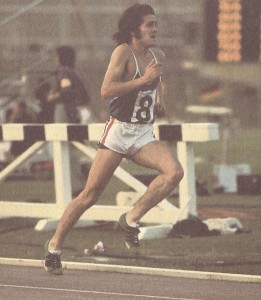
In the AAA’s 10000m in 1975: second in a Scottish National record
At the start of winter 1975, Devlin, Graham, Small and McDonald were in the team that was second in the Western District Championships and Jim Brown wasn’t seen until the Edinburgh to Glasgow on 15th November. John Graham had an uncharacteristically poor run on the first stage and handed over in tenth place to Jim who picked up six places against some of the very best runners in Scotland on the notoriously difficult second leg with the second fastest time, just 18 seconds behind Andy McKean. Clyde Valley was third, upholding the honour of the West of Scotland behind Edinburgh Southern Harriers and Edinburgh AC. Two weeks later at Gateshead in an international cross-country fixture Jim raced the top Englishmen including Brendan Foster, Dave Black and Bernie Ford and Belgians led by Jos Hermens and Poland’s Bronislaw Malinowski and ran well to finish eleventh – four down on McKean but one ahead of young Nat Muir. He was obviously running well because he was spoken of as pretty well certain of selection for the Scottish team for the cross-country international, but all his running was done in England and the results were not in the Scottish press. The British Universities Championships were held at Stirling University in February and he was runner-up to Ray Smedley and spoke to Ron Marshall afterwards. “Smedley’s runner-up on Saturday, Jim Brown from Holytown, was more than half a minute behind and had no intention of vying with the Englishman for a 5000m place. [in the 1976 Olympics]. “It’s the 10000 I’m after, but between now and the final Olympic trial in June I’ll run only one – and that’ll be at the trial,” Brown said after the race. Was he disappointed at having finished so far behind Smedley? “A bit, though I’m doing three track sessions a week at Crystal Palace (he finished physical education studies in London in the summer) and I think my track preparations are clashing a wee bit with grass running. It would have been nice to win because that was my last chance in student competition.”
Missing the National, he was selected for the international at Chepstow where 24-year-old Brown was twenty ninth – twenty places better than in 1974, as the press report kindly reminded its readers – and first Scot to finish.
Summer 1976 was Olympic year and Jim was running very well indeed. As he says above, he thinks his most disappointing race must have been the 1976 Olympic Trial at Crystal Palace. Previously he had been ranked third in Britain due to the fast 10000m the previous year. It was Jim’s final year at College, he was due to sit the Physical Education finals and although his training, especially speed work, had been going well, the competitive work outs that year had been much less good. In the race itself, he just went for it and reached halfway in just over 14 minutes. He says, “I recall the elation of thinking that I was nearly in the team but it was short lived as I tied up and finished the last half running backwards. I don’t think I have ever been so depressed or disappointed after a race.“
His own club’s 5 Miles Road Race was in mid-September and he was second to Jim Dingwall. Having completed his studies in London, Jim was out in the McAndrew Relay on 2nd October. Shettleston won but Jim had the fastest time of the day – 13:24 to Andy McKean’s 13:29. He had also taken up a position as coach at the brand new Coatbridge Outdoor Centre. Came the District Relay Championship on 6th November at Greenock and again Shettleston won, but this time, although ‘Brown gave a great display of power running as he lifted Clyde Valley eight places to fourth’ he had to be satisfied with second fastest, Nat Muir being two seconds quicker. The big one in November was always the Edinburgh to Glasgow Relay. Clyde Valley finished fifth with Jim on the long seven mile sixth stage where he moved up from sixth to fifth with third fastest time of the afternoon. When it came to the Scottish championships, Jim for probably the first time ever, dropped out of a race, the National on a snow covered trail at Glenrothes, but suffering from the after-effects of ‘flu he might not normally have run at all. The selectors understood and he was picked anyway for the international. The event was held in Dusseldorf over a 7.5 mile trail round a racecourse. Probably too short for most of the Scottish team which was led home by Allister Hutton in 14th with Jim 36th, Laurie Reilly 41st, Andy McKean 49th, Rees Ward 62nd, Paul Kenny 68th, John Graham 80th, John Robson 94th.
On 9th May, 1977, Jim was third in the Lanarkshire 1500m championship behind John Graham and Nat Muir in 4:03.3 – Graham’s time was 4:02.2 and Muir’s 4:02.8, Seven days later at Gourock, he was again third. This time it was in the 3000m at the Highland Games behind Lawrie Spence and John Graham. “Brown, who was not all that happy about the soggy, rutted nature of the track (“they should add it to the cross-country calendar,” he observed) now turns his attention to a classy 5000m field at in Wednesday’s Phillips Electrical meeting at Crystal Palace.” The race spoken of was a 5000m on 18th May at Crystal Palace against Africans and some of the very best Europeans. Eventually it was won by S Nyambui of Tanzania in 13:34..6. Jim hung on for as long as he could but fell away t finish 17th but ahead of such good men as Grenville Tuck, Jon Wigley, Steve Kenyon, Gerry Hannon and Merv Brameld. On 5th June, in an international between Scotland and Greece at Meadowbank, Jim won the 10000m easily in 29:18.04 in a match the Scotland lost – 99 points to Greece’s 112. By the end of the summer 1977 his best marks were 3:49.8 for 1500m (16th), 8:06.6 for 3000m (8th); 13:48.0 for 5000 (4th) and 29:18 for 10000m (6th).
The winter of 1977-78 started minus Brown, McDonald and company in the McAndrew Relay but the following week they defeated the winners of that race, Shettleston Harriers) in the Lanarkshire relays at Motherwell with Brown on the third stage running second fastest time behind Nat Muir. On the country in the District relay championships on 5th November Clyde Valley was sixth with John Graham being second fastest on the day and Jim being fourth fastest. In the Edinburgh to Glasgow on 19th November, he was on the second stage of the Edinburgh to Glasgow Relay and picked up two places, from fourth to second, with the third fastest of the day, only Nat Muir and Andy McKean being faster. On 8th December at Bellshill, Jim won the County championship on a course so bad that several refused to run on it: this was not just a problem for Lanarkshire, however, as Andy McKean was criticising the course at Stirling used for the inter-area race on the same day. On 10th December he ran in an international race at Crystal Palace but finished down the order for a Scottish team that finished fourth. Missing from the early 1978 races such as the Nigel Barge Road Race and the Spanish invitations, it was said at the District Championships late in January that Jim had some important races coming up. In the National championships at Bellahouston Park in Glasgow, Jim Brown was fourth behind Hutton, Ward and McKean, on the same time as Phil Dolan and in front of Ian Gilmour, Frank Clement and John Myatt. Selected for the international later that month, Jim had a real off-day and finished outside the first hundred.
That summer Jim began with a fast 5000 at Carluke in the Lanarkshire championships where he won in 14:02.0. On 14th May he ran in a Scottish team in Athens against Greece, Wales and Luxembourg and justified his selection with first place in the 10000m in 28:36.4 from Allister Hutton in second on 28:37.1. The SAAA 10000m championship was held at Grangemouth two weeks later on 27th May and Jim was second to Allister Hutton. The report read: “Hutton must wait a fortnight to find out if his winning time, 29:07.8, taken into account with other performances this year, finds approval with selectors. Both Hutton and Jim Brown, his runner-up nearly half a minute behind, have run much faster (28:36 and 28:37 in Athens), and Hutton was third in last year’s British championships. I have the feeling that our respectable traditions in middle-distance running might just win the day for Hutton with an outside chance for Brown.” When the team was announced on 11th June, 1978, there was no place for Jim Brown. This was despite the fact that there was only one second between them and the run at Grangemouth had cost him his place. He was not alone in his disappointment – there were several others, such as Graham Williamson, with good claims to selection who were left off the list. The most egregious was the omission and selection on the same day of high jumper Brian Burgess, SAAA Champion! Not selected for the team which was announced on the Sunday morning, he leapt 7’2″ that afternoon and was selected before bedtime. That didn’t help Jim at all who missed another Games. Nevertheless by the end of summer 1978 he was ranked fifth in the 5000m with 14:02.0, and topped the 10,000m list with 28:36.37 ahead of Allister Hutton (28:37.08 and Jim Dingwall (28:45.25) with the next man outside 30 minutes.
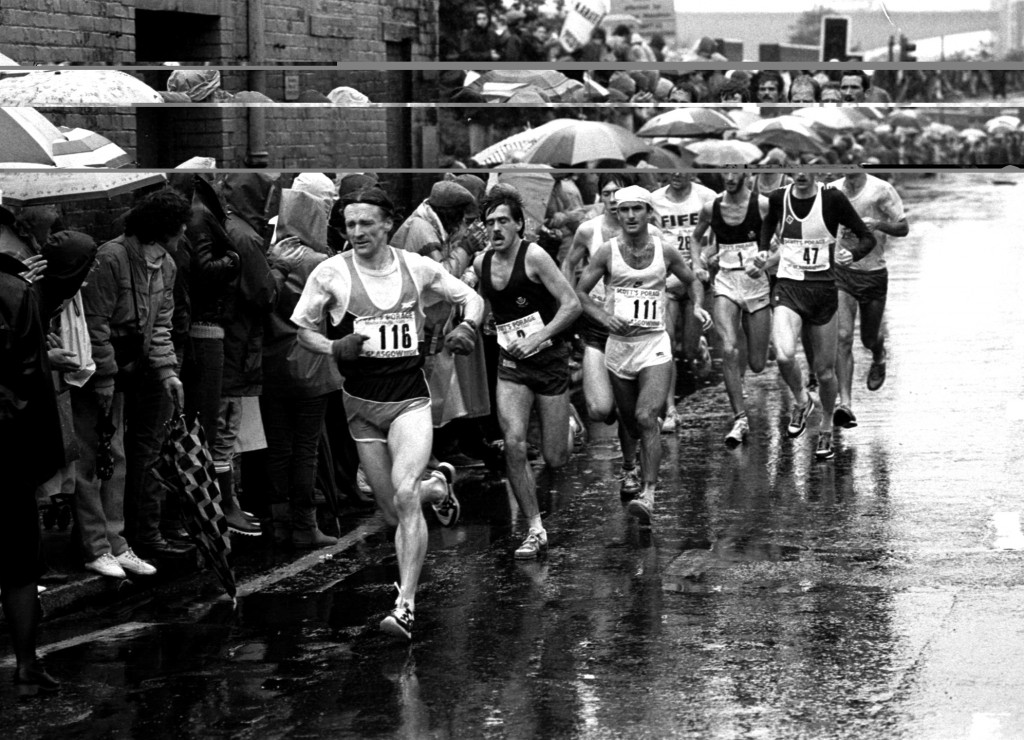
Jim (black vest, running second) in Glasgow Marathon, 1985
A Graham MacIndoe picture
At the start of winter 1978-79, Jim ran a very good leg of the McAndrew relay lifting Clyde Valley from sixteenth to first on the second stage and running the fastest time of the day (three seconds faster than Nat Muir) – team mates Brian McSloy (fastest Junior) and Willie Marshall (fastest over 50) also took individual honours although the team could only finish fifth. A week later, another relay and Jim again beat Nat for fastest time – this was in the Lanarkshire relay and Clyde Valley were second this time. Nat beat him to it in the District relay at Bearsden seven days later with Clyde Valley third. The rivalry continued into November and the Allan Scally Relay at Barrachnie on the fourth of the month, organised by Nat’s club, Shettleston Harriers. The headline on the report read:
“BROWN IS FASTEST AFTER RE-SCRUTINY
One runner had reason to feel aggrieved on Saturday after the results of the Allan Scally Relay had been worked out and the prizes awarded. Jim Brown had looked fast but the results sheet thought not. After a third-stage run round a course of nearly five miles at Baillieston, Brown pushed Clyde Valley from seventh to third place and was given a time of 22 min 42 sec. The award to the fastest individual eventually went to Nat Muir (Shettleston) whose last leg of 22 min 23 sec looked invincible. Brown was confident enough to query the decision, knowing that four or five others separated him from Muir according to the paper calculations and such has been Brown’s level of performance this season, that he was shocked to learn how far back he was listed. All was put right yesterday (Sunday) however after a re-scrutiny revealed a 20 second error in Brown’s favour, so he actually pips Muir for fastest award by just one second.” Edinburgh Southern Harriers won the race from Shettleston and Spango Valley. Jim chose to miss the Glasgow University Road Race on 11th November, won by Nat Muir for the third successive year, but ran an outstanding second leg of the Edinburgh to Glasgow where he pulled the club from twelfth to second in the fastest time of the afternoon, then on the last Saturday of the month finished twentieth in the international races at Gateshead. |Having been racing almost without respite, Jim won the Lanarkshire Six Miles Cross-Country Championship on 2nd December yet again but missed the Nigel Barge at Maryhill and the Western District Championships, held in driving sleet and rain in Bellahouston Park in mid January. The Scottish championships were held at Livingston an frozen, rock hard, traditional cross-country trail where the mud had been frozen into ridges and rocks cemented into the ground. Nat Muir was the winner with Lawrie Spence second, Half a minute down, and Jim Brown third, a further 23 seconds back with Jim Dingwall fourth. The team for the international cross-country in Limerick two weeks later was not announced till 4th March and Jim was in for the sixth successive year – as were Allister Hutton and Laurie Reilly.
Summer 1979 was the year that Jim started on his marathon running career – obviously not to the exclusion of track running – by the end of that season he had best times of 8:13.4 for 3000m, 14:00.5 for 5000, 28:58.0 for 10000 and 2:22:22 for the marathon. They ranked him 8th, 8th, 1st and 11th in Scotland. He started the season with his second win in the Tom Scott 10 Miles Road Race in April. The report this time was short – he had beaten Graham Laing of Aberdeen in a field of 72 runners in 48 minutes 04 seconds with Laing on 49 minutes 19 seconds and Martin Craven third. He then won the 3000m at Carluke on 2nd June in 8:48.4 and the following week had an interesting double at the East Kilbride Games – he won the 6 miles road race despite taking a wrong turning at one point and then won the 3000m on the track just ten minutes later. In the SAAA Championships on 16th June, Jim was third in the 5000m behind Nat Muir and Allister Hutton where the winner ran 13:57.4. It was not until 16th September though that Jim made his marathon debut – running in the Norco Aberdeen Marathon he finished second to another marathon debutant – local boy and future SAAA marathon champion Graham Laing, who won in 2:21:40 with Colin Youngson third in 2:27:44 and a whole host of experienced marathon men behind him, eg Willie Day, Doug Gunstone, Colin Martin, Evan Cameron and Alastair Wood. When asked why he had taken up the marathon, and whether anyone had advised him or suggested to him that he do so, he replied that he just decided to do it – it was of course a time when the event had a very high profile world wide and many, many other runners were taking the same line and ‘giving it a try’. Very few had his success in the event though.
That winter, 1979/80, he started his campaign with third fastest time of the day in the McAndrew Relay when Clyde Valley was second to Shettleston in the team race. He then missed the Lanarkshire and West District relay championships but came out in the National event on 27th October when the club won with Brown himself turning in the fastest time of the day. Into November and Clyde Valley won the Edinburgh to Glasgow Relay by two minutes from Edinburgh AC with Edinburgh Southern seconds. It was a very good team – Farquharson, Graham, Agnew, McSloy, Devlin, Brown, Marshall and Fox – with Graham, McSloy and Brown running the fastest times on their respective stages. Brown held and extended the lead given to him by Eddie Devlin giving David Marshall a three minute cushion over the EAC runner. On 1st December, Jim won the Lanarkshire Cross-Country title, and ran the following week in an international match at Crystal Palace in which he was unplaced. On 5th January, 1980, Jim and Gordon Rimmer of Cambuslang were contesting the lead when they took the wrong turning at Canniesburn Toll, going 100 yards off course, and let Jim Dingwall get past. By the end Rimmer won from Dingwall but Jim was off with Rimmer and Graham Clark of Spango Valley the next week to Elgoibar. Jim was third in the Spanish classic, only six seconds behind the winner John Wild of England. A week later he travelled back to Spain with a small Scottish squad led by Nat Muir to race in San Sebastian. Muir was an excellent third with Jim Brown fifth and Lawrie Spence 15th to give Scotland second place in the team race.
Jim was eighth in the National with Clyde Valley finishing second team and on 16th February, 1980, the headline read “BROWN WILL CAPTAIN WORLD CHAMPIONSHIP SCOTS”. A headline that most Scots, whatever their sport, would give their eye teeth for. Jim had been announced as the team captain for the world cross-country championships to be held in March. It went on : “Scotland’s team for the World Championships next month in Paris followed predictable lines when the selection was made yesterday in Grangemouth. The selectors held their final trial for the Junior team just before lunchtime and as brief a conclave to find the nine seniors and six juniors as has been held in recent times came up with no surprises. Jim Brown, long-toothed at this level of competition, captains the seniors of whom Nat Muir, the National champion, will be expected to set an example to the others at Longchamps racecourse on March 9th. The other seniors selected – Graham Clark (Spango Valley), John Graham (Clyde Valley), Allister Hutton (Edinburgh Southern), Brian McSloy (Clyde Valley), Gordon Rimmer (Cambuslang), John Robson (Edinburgh Southern), Lawrie Spence (Shettleston).”
In the International itself, the team did not run up to expectations, Jim finishing 31st, with Nat Muir tenth and John Robson in fifty second. The next race is always the important one, and Jim headed for the summer, 1980, track and road racing.
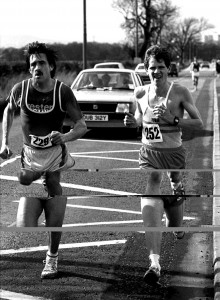
Jim with Alex Robertson: Tom Scott Road Race 1985
Graham MacIndoe
The second running of the National Six-Stage Road Race was held at the end of March, 1980, and Jim almost fell out with the club selectors when he requested a short stage rather than one of the six-mile legs – because he wanted to race at Berwick the next day. He ran Stage Five, producing the day’s fastest time of 18:15 opening a gap of 46 seconds over the second club. By the end of the race, Clyde Valley was second to Edinburgh Southern Harriers and 8 seconds ahead of Falkirk Victoria. Jim ran the next day in a 10 mile race at Barrow-in-Furness – and won from a strong English field in 46:55.
On April 14th 1980, the headline and article read:
“LEG WORK PAYS OFF FOR BROWN
Jim Brown (Clyde Valley) retained his title in the Tom Scott Memorial Road Race from Law to Motherwell on Saturday. He was in excellent form, just failing to break his own record by one second and finished 400 yards ahead of Allister Hutton (Edinburgh Southern Harriers) who was running over the ten miles distance for the first time. Brown, whose winning time was 46 minutes 34 seconds, has been doing high mileage training of 120 miles per week preparing for the AAA’s marathon championship at Milton Keynes in three weeks times. This heavy schedule is paying off for Brown as he looked and felt very fit. He said after the race that he had intended waiting until the seven mile mark before making his effort, but he felt so good that he decided to go at three miles after he had been in the leading bunch with Hutton, Dingwall, Martin Craven (Edinburgh Southern) and Colin Farquharson (Clyde Valley).”
Although not placed at Milton Keynes, by the end of the summer Jim was ranked in four events – the 3000m, the 5000m, the 10000m and the marathon with the 10,000m again being his best event going by the rankings. Times and places were 8:14.9 (10th), 14:09.8 (5th), 29:27.9 (2nd) and 2:19:03 (5th).
In the McAndrew on 4th October, 1980, Clyde Valley won the race very comfortably and Jim only had to run round the course to ensure a Clyde Valley victory over Edinburgh Southern Harriers and Shettleston. In the District Relays there was no Clyde Valley team but they made up for it in the National Relays when Jim Ran on the second leg for the team which finished second. In the Edinburgh to Glasgow on 16th November 1980, Clyde Valley were taken into a lead on the long sixth stage which they never lost and they took home the gold medals. Jim ran the fastest time of the day on the stage 47 seconds up on second fastest runner, Eddie Stewart of Cambuslang. When it came to cross-country running in 1980-81, Jim was in great form. He won the West District Championships in January and the ‘Glasgow Herald’ made the most of it with the headline of “BROWN RECOVERS AND MAKES IT LOOK EASY” above an article pointing out that he had been slightly adrift at the end of the first lap of Bellahouston Park buut when he went in front on the next lap, the issue was never in doubt. In the National Cross-Country Championship in 1981, Jim was second – only two seconds down – to Nat Muir. In dreadful snowy conditions they were both clear by 4 miles and just raced it out all the way to the finishing line. The International Cross-Country Championships were held in Madrid but almost all of the Scottish party were stricken with a mystery illness and four runners – Fraser Clyne Graham Williamson and Jim Brown all had to drop out of the race. In the National 6 stage relay in March, Edinburgh Southern were the victors with a weakened Clyde Valley (Jim on the anchor leg) finished fifth.
That summer he ran his best 5000m on 20th June at Meadowbank in the SAAA Championships where he could only finish fourth in 14:18.46 which ranked him seventh in the country at the end of the summer. He was undoubtedly running well and on 2nd August at Meadowbank in the International against Denmark and Eire he won the 10000m in 29:40.54 – his best for the summer and it ranked him third in the country at the end of the season.
At the start of winter 1981-82, Jim did not run in either the McAndrew Relay, the Lanarkshire Relay Championships the West District or even the National relays but did run in the Edinburgh to Glasgow in late November. Jim ran, unusually for him on the shortest stage in the race, the third, and wasn’t even in the top four times on what was generally regarded as the ‘easiest’ stage (although ‘easy’ is a relative term, there were no easy runs in the E-G!). Bearing in mind that Jim never gave less than 100% effort, he was clearly injured. He was nevertheless back in action in the New Year when, after passing up on the Beith and Nigel Barge races, He turned out on 23rd January in the West District Championships, where he was second to Lawrie Spence, only two seconds down on the Greenock man. In the National a month later he was sixth (two places behind Clyde Valley team mate Ron McDonald) . So he’d be in the team for the international? No, he wasn’t and the ‘Glasgow Herald’ correspondent explained that Jim wanted to concentrate on training for the marathon. In April 1982 it was back to the Tom Scott 10 Miles Road Race – it was a race that he liked with three victories over the years. This time he was second to Allister Hutton: Hutton ran a course record of 46:05 but Jim was also inside the previous best with 46:27 – 6 seconds inside his own old record.
In 1982 with the assistance of team mate John Graham who had won in an exceptionally fast time the year before, Jim ran a marathon in Rotterdam, and it was in general quite a good year for him. There was the Scottish International against South Belgium and Luxembourg in Luxembourg) on 12th June in which Jim and Lawrie Spence both. ran in the 1000m where Lawrie won in 29:04.22 and Jim was fourth in 30:38.33. This was his best and only track ranking time of the year and placed him 13th. His best marathon time was in Glasgow on 17th October when he was timed at 2:20:38. That placed him fourth in the race and eleventh in Scotland. Doug Gillon reported on the race.
“Forster (Glenn Forster from England who won the race) was always in the leading group but he gambled shortly before the halfway mark when the American Emil Magallanes attempted to break the field. “Magallanes took a lead of nearly 100 yards but I decided not to go with him,” said Forster. It was the top runner in the three-man Scottish team, Jim Brown of Clyde Valley, who set out in pursuit with Fleming. Gradually they pulled in Magallanes whose break had proved indecisive. Forster caught the two Scots and the three together finally nailed down the flagging American from Oakland by the 14 mile mark.
Brown and Fleming had a nine second lead over Forster at 15 miles, reached in 71 minutes 01 second. By that stage Magallanes had drifted 16 seconds down on the two Scots and gradually drifted backwards through the field. Fleming, running through Ibrox, his home area, was cheered from the windows, “You’re having a great race, Peter,” said Brown, aware that the 21-year-old was running only his second marathon, was well on schedule to smash his best time. “I can’t slow down here, not in front of the neighbours,” came the reply. By 20 miles reached in 1:44:19 Forster was back up with the two Scots, Bark having been 23 seconds off the pace at 15 miles, had closed to just 12 seconds down, mounting his challenge over the last six miles.
“It was at 22 miles that I finally cracked,” said Brown, who had looked for long as though he could give Scotland a home victory, despite being bitten by a Doberman Pinscher on his final winding down training run on Wednesday. “I wondered why you sprinted every time a dog barked,” cracked his team mate Evan Cameron who finished ninth. Brown goes for a tetanus injection today. His muscles would have been liable to stiffen up had the inoculation been given before he started the run. But 30 year old Brown could not raise any steam when Forster began took up the running. “
The leading runners and times were 1. G Forster 2:17:16; 2. C Bark 2:18:36; 3. P Fleming 2:19:40; 4. J Brown 2:20:38; 5. N McCarron 2:21:26; 6. T Jordan 2:21:34; 7. A Daly 2:24:41 8. M Crowell 2:21:54; 9. E Cameron 2:21:58; 10. D Macgregor 2:22:06.
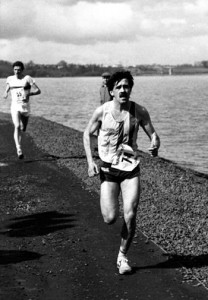
Jim the club runner: Six Stage Road Relay, 1986
Graham MacIndoe
The winter season in Britain usually starts in October and the marathon being run on the 17th October affected training and racing patterns for many athletes. The West District Relays were on the day before the marathon and all teams were rather thin. Jim missed all the relays up to the Edinburgh to Glasgow where he ran on the first stage, finishing third behind Nigel Jones (Edinburgh AC) and Don Macgregor (Fife AC) – 10 second down on Jones and 2 down on Macgregor in a Clyde Valley team that finished twelfth. Other than that, Jim Brown was not seen in any of the major races over the winter of 1982-83. Next summer he was not ranked in any event between 3000m and the marathon inclusive. Injury was a constant problem for him at this point. and he was absent from all his favourite events such as the Tom Scott which he really loved racing in and in which, up to that point, he had three firsts and four seconds. He did not appear in any of the major races that season and at the start of winter 1983-84 there was little sign of Clyde Valley AC never mind Jim Brown in the opening relays. There were no club teams in the National relay at all but all the top men were out in the Edinburgh to Glasgow. Jim again ran the first stage finishing sixth this time to be followed by Ron McDonald who picked up to fourth and the team went up and down the top four or five teams until the finally crossed the finishing line in bronze medal position. Jim was clearly not in his usual form. He continued to miss races – he did not figure in either the District and National Championships. In the course of his career Jim had been plagued with injury – he had injuries to his calf and both Achilles tendons had surgery performed on them. At this point in his career these injuries, as well as the growing business and family commitments, led to a restriction on his racing programme. One race that was on the schedule however was at the end of September. He was out again in the Glasgow Marathon on 30th September and finished eleventh in 2:19:08. The race was won by England’s David Lowes in 2:15:31 with Annan’s Mike Carroll finishing in 2:16:24. That time ranked Jim 15th for the event at the season’s end.
By now Jim was racing only infrequently for the reasons quoted – injuries, career and family responsibilities – and in winter 1984-85 his first race was in the Edinburgh to Glasgow on 18th November when he ran on the fourth stage where his time was eighth fastest on the day and he maintained the club’s 19th position. This was his only race that winter but he started 1985’s road season with second to Alan Puckrin in the Tom Scott, his time of 50:49, almost a minute and a half down on Puckrin but six seconds clear of Alex Robertson after outsprinting him in to the finish. Clyde Valley won the team race with 28 points to Dumbarton’s 38. He finished the summer with another sub 2:20 marathon when he turned out in Glasgow on 22nd September, finished twelfth and ran 2:19:59 – Mike Carroll was first Scot to finish (sixth) in 2:18:24 – on a day when the race was dominated by the English.
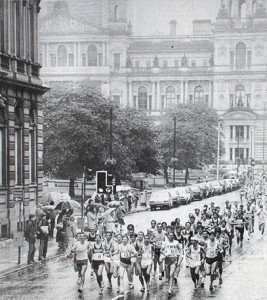
Start of Glasgow Marathon 1985
By October 1985, Jim was racing very infrequently and, almost as important, Clyde Valley AAC (originally an amalgamation of five local clubs) had disbanded and the runners returned to their local groups. Jim was now running for Motherwell. He didn’t turn out in the short relays, nor in the Edinburgh to Glasgow but did race in the Six Stage Road Relay in March 1986. He ran on the fourth stage and pulled the team up two places from ninth to seventh. And this is his last major appearance.
Unlike many other top runners, Jim did not gradually fade away, falling slowly – or not so slowly – down the field and down the ratings in slower and slower times. He had a good job with the local council, he had a satisfying domestic life and he just stopped with that good run. He had had a very good career indeed – he ran for Scottish Schools, Scottish Under 20’s, Scottish seniors and British Seniors; he won championship titles at Schools, Scottish and British level and was for some time among the very best in Britain and, indeed, in Europe. Scottish athletics lost a lot when Jim Brown hung up his spikes.
